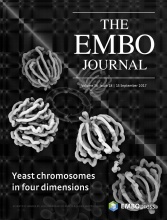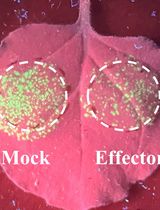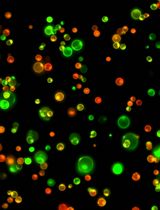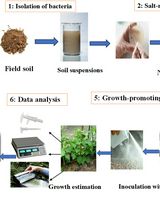- EN - English
- CN - 中文
Quantification of Plant Cell Death by Electrolyte Leakage Assay
通过电解质渗漏测定法定量植物细胞死亡
发布: 2018年03月05日第8卷第5期 DOI: 10.21769/BioProtoc.2758 浏览次数: 24270
评审: Andrea PuharBin TianAnonymous reviewer(s)
Abstract
We describe a protocol to measure the electrolyte leakage from plant tissues, resulting from loss of cell membrane integrity, which is a common definition of cell death. This simple protocol is designed to measure the electrolyte leakage from a tissue sample over a time course, so that the extent of cell death in the tissue can be monitored dynamically. In addition, it is easy to handle many tissue samples in parallel, which allows a high level of biological replication. Although the protocol is exemplified by cell death in Arabidopsis in response to pathogen challenge, it is easily applicable to other types of plant cell death.
Keywords: Plants (植物)Background
When a cell dies and loses the integrity of the cell membrane, electrolytes, such as K+ ions, leak out of the cell. Thus, we can use the amount of electrolytes leaked from a tissue as a proxy for the extent of cell death in the tissue. A simple way to quantify such electrolytes leaked from a tissue is to measure the increase in electrolytic conductivity of water that contains the tissue with dying cells. This electrolyte leakage assay has been applied to plant tissues to assess the relative quantity of cells that died in response to biotic and abiotic stresses, such as pathogen challenge, insect herbivory, wounding, UV radiation, oxidative stress, salinity, drought, cold and heat stress (Demidchik et al., 2014).
The original method was designed to measure the conductivity of the aqueous bathing solution containing plant tissues before and after boiling it, in which the conductivity after boiling was used to normalize tissue size differences (Whitlow et al., 1992). Here we describe a procedure to dynamically monitor electrolyte leakage from leaf disks by measuring at multiple time points the electrolytic conductivity of water on which the leaf disks float in a 12-well plate. It is reasonable to assume that the total amount of electrolytes from tissue samples of the same size, such as disks of the same area punched out from leaves of a similar developmental stage, is comparable and that it is not necessary to measure the electrolytic conductivity after boiling the tissues. We inoculated leaves with the bacterial pathogen, Pseudomonas syringae pv. tomato DC3000 pVSP61-avrRpt2 (Pto DC3000 avrRpt2) in order to trigger a type of programmed cell death, known as hypersensitive cell death. The protocol presented here has been applied to our studies (Igarashi et al., 2013; Bethke et al., 2016; Hatsugai et al., 2016; Hatsugai et al., 2017) and could also be used to quantify plant cell death triggered by any other stimuli. If detailed comparisons of the time courses of the electrolyte leakage are needed, fitting polynomial regression to the time courses is possible (Van Poecke et al., 2007; Qi et al., 2010), as it is easy to obtain electrolytic conductivity measurements at many time points with many replicates.
Materials and Reagents
- 2 ml microcentrifuge tubes (Fisher Scientific, catalog number: 05-408-138 )
- Sterilized tubes for liquid bacterial cultures (Evergreen Scientific, catalog number: 222-2094-050 )
- Disposable 1-ml needleless syringes for bacterial inoculation (BD, catalog number: 309659 )
- 12-well cell culture plates (flat bottom with lid) (Corning, Costar®, catalog number: 3513 )
- 1-200 μl Pipette tips (Sorenson BioScience, catalog number: 3211 )
- 50-1,250 μl pipette tips (Sorenson BioScience, catalog number: 3205 )
- Arabidopsis thaliana accession Col-0 (Figure 1A)
Note: Arabidopsis thaliana accession Col-0 carries the R gene RPS2, which confers resistance to Pto DC3000 avrRpt2 (Bent et al., 1994; Mindrinos et al., 1994). - Pseudomonas syringae pv. tomato DC3000 pVSP61-avrRpt2 (Pto DC3000 avrRpt2)
Note: Pto DC3000 avrRpt2 delivers the AvrRpt2 effector into plant cells, thereby inducing hypersensitive cell death in Arabidopsis Col-0. - Sterilized ultrapure water (e.g., Milli-Q)
- Conductivity standard solution 1.41 mS/cm (HORIBA, model: Y071L, catalog number: 514-22 )
- Antibiotics
- Bacto proteose peptone No. 3 (BD, catalog number: 211693 )
- Glycerol (Fisher Scientific, catalog number: G33-500 )
- Dibasic potassium phosphate (K2HPO4) (Fisher Scientific, catalog number: BP363-500 )
- Bacto agar (BD, catalog number: 214010 )
- Hydrochloric acid (HCl) (Fisher Scientific, catalog number: A508-P500 )
- Magnesium sulfate heptahydrate (MgSO4·7H2O) (Sigma-Aldrich, catalog number: 230391 )
- King’s B liquid medium (see Recipes)
Equipment
- Walk-in Arabidopsis growth chamber (22 °C, 70% relative humidity, and 12-h/12-h day/night photoperiod) (Conviron, model: BDR40 )
- Tissue culture roller rotator drum for bacterial culture at 28 °C (New Brunswick Scientific, model TC-7 )
- Centrifuge (Eppendorf, model: 5415 D )
- Spectrophotometer to determine the density of bacterial culture (Beckman Coulter, model: DU-800 )
- Cork borer (size 4, diameter = 7.5 mm)
- Electrolytic conductivity meter (HORIBA, model: B-173 )
- Single-channel micropipettor (Eppendorf, 20-200 μl and 100-1,000 μl)
- Autoclave
Software
- Microsoft Excel
Procedure
文章信息
版权信息
© 2018 The Authors; exclusive licensee Bio-protocol LLC.
如何引用
Hatsugai, N. and Katagiri, F. (2018). Quantification of Plant Cell Death by Electrolyte Leakage Assay. Bio-protocol 8(5): e2758. DOI: 10.21769/BioProtoc.2758.
分类
植物科学 > 植物免疫 > 宿主-细菌相互作用
植物科学 > 植物免疫 > 病害生物测定
生物化学 > 其它化合物 > 离子
您对这篇实验方法有问题吗?
在此处发布您的问题,我们将邀请本文作者来回答。同时,我们会将您的问题发布到Bio-protocol Exchange,以便寻求社区成员的帮助。
Share
Bluesky
X
Copy link













